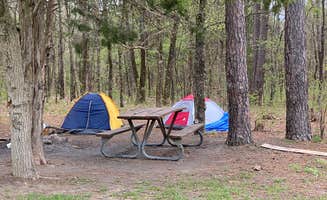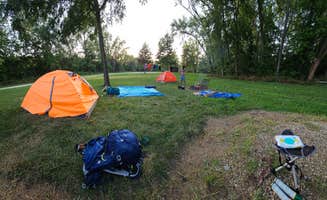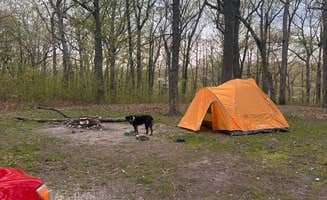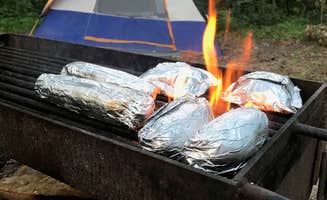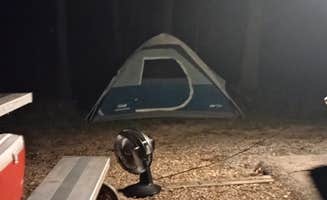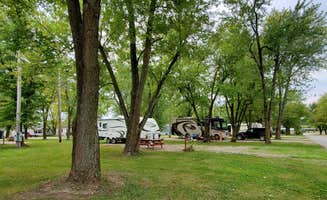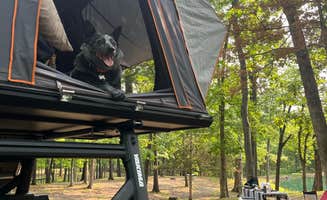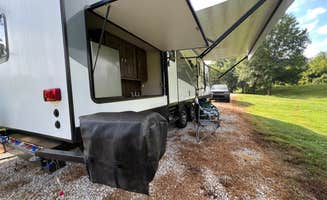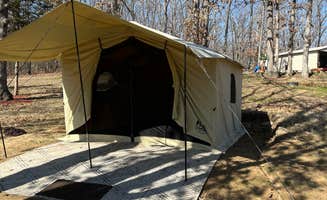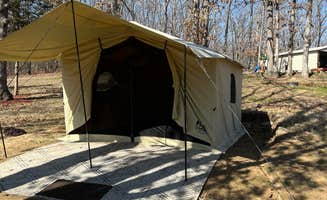Primitive camping options abound near Rhineland, Missouri, with several conservation areas situated within 20 miles of town. The Missouri River valley terrain features a mix of hardwood forests, limestone outcroppings, and river access points where camping is permitted. Conservation areas typically offer free camping with minimal facilities, while developed campgrounds provide hookups for $20-35 per night depending on the season.
What to do
Fishing opportunities: 45 minutes from Rhineland at Fredericksburg Ferry Access, where the Gasconade River provides good fishing spots. "Fredericksburg Access is a free campground with about 10 primitive sites. Grassy coverage with a mix of gravel or grass pull-ins. Lots of trees but still great stargazing at night," notes one Fredericksburg Ferry Access visitor.
Historic cave exploration: Graham Cave State Park features a significant archaeological site with evidence of human habitation dating back 10,000 years. "Massive cave with archaeological dig site. Great trails and wet weather waterfalls. Right off the side of the highway," reports a camper at Graham Cave State Park Campground.
Hiking and wildlife watching: Daniel Boone Conservation Area offers multiple trail systems through diverse terrain. "There's some stocked ponds to fish in and trails to explore. We rode the Katy Trail which is only 3.5 miles down the hill from here," explains a visitor who found the location convenient for combining activities.
What campers like
Quiet weekday camping: Conservation areas rarely fill up on weekdays, even during summer. "Just passing through, we decided to start looking for a place to stay for the night. Got there and it was beautiful. The landscaping was kept up with, full hook ups, They have a pool, fenced in dog area," shares a camper at Hickory Ridge Campground.
Dark sky viewing: The rural setting provides excellent stargazing conditions. "Lots of trees but still great stargazing at night. We even saw a few meteors!" reports a Fredericksburg Ferry Access camper who enjoyed the astronomical display.
Budget-friendly options: Free camping is available at conservation areas. "Danville Conservation Area is a no-fee peaceful spot that is only about six miles from I-70 but feels deep into the wilderness," notes a visitor who appreciated the value and seclusion.
What you should know
Limited amenities at conservation areas: Most primitive sites have no water, trash service or electricity. "There is no water, electricity or trash so please pack out your trash. There are trees everywhere so I wasn't able to completely optimize my solar but was able to still get sun," explains a visitor to Danville Conservation Area.
Cell service varies: Coverage depends on carrier and exact location. "I had between 2-3 bars of 5G via AT&T and could work efficiently," reports a camper at Danville Conservation Area.
Seasonal considerations: Many developed campgrounds close during winter months. "Drive was safe in our heavy converted camper van. No off road vehicle or AWD needed. It had just rained but wasn't too mucky," mentions a summer camper at Fredericksburg Access.
Reservation requirements: Some private campgrounds need advance bookings while conservation areas are first-come, first-served. "All sites had red tags stating reservations recommended but were not required. There were plenty of sites available when we were there," notes a fall visitor to Graham Cave State Park.
Tips for camping with families
Kid-friendly campgrounds: Some locations offer swimming and play areas. "Wow! From the moment we pulled in Lazy Day is awesome. The pool - pristine, the store - adorable, the grounds - beautiful," shares an enthusiastic family visitor to Lazy Day Campground.
River access safety: Monitor children near the Gasconade River. "The swim there requires crossing a moderately sized river that is relatively swift. This is fine for people who swim well but not recommended for young children or weak swimmers especially without flotation devices," cautions a Fredericksburg Ferry Access visitor.
Educational opportunities: Graham Cave State Park offers interpretive programs. "We camped with our dog and had a nice time. We hiked the trails and saw the cave," reports a visitor who found the experience educational despite limited cave access.
Tips from RVers
Site selection for larger rigs: Look for pull-through sites at developed campgrounds. "The campground was easy to find, located just 5 miles off I-70 with clear signage along the way. We parked at the designated registration area, and check-in was quick for our one-night stay. We were then escorted to pull-through site 17 with full hookups," explains a camper at Lazy Day Campground.
Leveling challenges: Many sites require leveling equipment. "There are a few flat sites but many were not level," warns a Graham Cave State Park visitor.
Hookup locations: Check the position of utilities when selecting a site. "The gravel pad was fairly level, and although the utilities were toward the back of the site, we had no trouble connecting. There were two sewer hookups—a nice touch. Water is shared, but the pressure was solid at about 50 psi," notes an experienced RVer at Lazy Day Campground.



